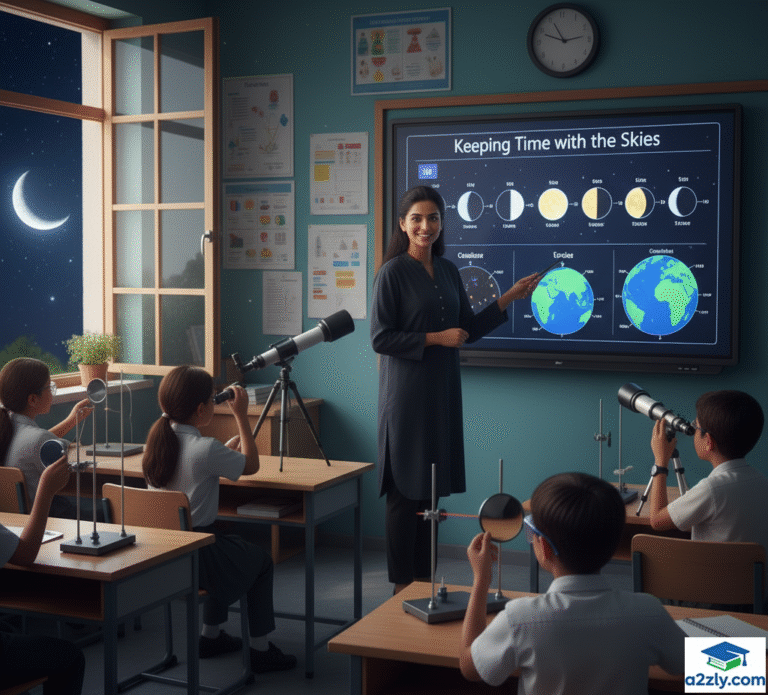🧭 Chapter Overview
Imagine a world without clocks or calendars — how would you know the time or the day of the year? Ancient humans turned to the skies for answers. The rising and setting of the Sun, the changing phases of the Moon, and the repeating patterns of stars became nature’s clocks.
This chapter, “Keeping Time with the Skies”, explores how astronomical movements — the rotation and revolution of the Earth and Moon — gave birth to days, months, and years. You’ll also discover India’s rich heritage in calendar-making and modern scientific applications like artificial satellites.
Table of Contents
🎯 Learning Objectives (NEP 2025 Competency Table)
| Competency | Learning Outcome | NEP Skill |
|---|---|---|
| Conceptual Understanding | Explain phases of the Moon & lunar cycles | Conceptual Clarity |
| Analytical Thinking | Relate natural phenomena to time measurement | Critical Analysis |
| Application | Identify types of calendars & leap years | Practical Competence |
| Experimental Learning | Observe Moon phases & shadows | Inquiry & Observation |
| Cultural Appreciation | Explore India’s astronomical heritage | Heritage & Values |
🌙 11.1 How Does the Moon’s Appearance Change and Why?
Have you ever noticed that the Moon doesn’t look the same every night? Some nights it’s a perfect circle, while on others it’s a thin crescent. These changing shapes are called phases of the Moon.
🌗 11.1.1 Phases of the Moon
The Moon doesn’t produce its own light. It shines by reflecting sunlight.
But because the Moon revolves around Earth, we see different portions of its sunlit half.
Phases of the Moon:
- New Moon (Amavasya) – Not visible.
- Crescent Moon – A thin curved sliver appears.
- First Quarter – Half of the Moon’s face is visible.
- Full Moon (Purnima) – The entire face is illuminated.
- Last Quarter – Half again, but the opposite side.
- Waning Crescent – The illuminated part shrinks again.
Each phase transitions over ~29.5 days — one lunar month.
| Term | Meaning |
|---|---|
| Waxing | Bright portion increasing |
| Waning | Bright portion decreasing |
In India, the waxing period is called Shukla Paksha, and the waning period is called Krishna Paksha.
🧪 Activity Insight: Observe the Moon
Try watching the Moon daily for a month. Draw or photograph its visible shape.
You’ll see the illuminated portion changing, proving the Moon’s revolution around Earth causes its phases — not Earth’s shadow.
🌍 11.1.2 Locating the Moon
- On a full Moon day, the Moon is opposite the Sun — visible all night.
- Each following day, it rises about 50 minutes later and appears closer to the Sun in the sky.
- On new Moon day, it’s between Earth and the Sun — invisible due to sunlight glare.
Thus, the Moon’s position and timing change daily.
🌑 11.1.3 Why Do the Moon’s Phases Occur?
Because only one half of the Moon is lit by the Sun at a time.
From Earth, we see varying portions of this lit half as the Moon revolves.
Key Concept:
“The Moon’s shape never changes — only the visible illuminated part does.”
Experiment Idea:
Use a ball, torch, and yourself as the Earth. Rotate around the “Sun” to see how light and shadow change — simulating Moon phases.
🌕 11.2 How Did Calendars Come into Existence?
Before digital clocks or watches, nature itself acted as a timekeeper.
🕐 A Day
A day is based on Earth’s rotation — one full spin (24 hours).
The Sun appears to rise in the east and set in the west due to this rotation.
Activity:
Fix a stick in sunlight and track the shadow’s movement.
The shortest shadow indicates noon, showing Earth’s rotation.
🌓 A Month
A month originates from the Moon’s revolution around Earth (~29.5 days).
The repeating cycle of Moon phases inspired early lunar calendars.
🌞 A Year
A year comes from Earth’s revolution around the Sun (~365¼ days).
The changing seasons — spring, summer, monsoon, and winter — complete one solar year.
📅 11.2.1 Types of Calendars
🌕 Lunar Calendar
- Based on Moon’s cycles (12 lunar months = ~354 days).
- Shorter than a solar year.
- Festivals like Eid and Diwali are linked to lunar months.
🌞 Solar Calendar
- Based on the Earth’s revolution around the Sun.
- Gregorian calendar (used worldwide) has 365 days.
- Adds a leap year every 4 years to match seasons.
🌓 Luni-Solar Calendar
- Combines lunar and solar cycles.
- Adds an extra month every 2–3 years (Adhika Maas) to align with seasons.
- Used in Indian calendars like Panchang.
📖 Indian National Calendar (Saka Calendar)
Introduced in 1957 after the Calendar Reform Committee led by Meghnad Saha, the Saka Calendar is India’s official solar calendar.
| Month | Duration | Corresponding Gregorian Months |
|---|---|---|
| Chaitra | 30–31 days | March–April |
| Vaisakha | 31 days | April–May |
| Jyeshtha | 31 days | May–June |
| Ashadha | 31 days | June–July |
| Shravana | 31 days | July–August |
| Bhadrapada | 30 days | August–September |
| Ashwin | 30 days | September–October |
| Kartika | 30 days | October–November |
| Margashirsha | 30 days | November–December |
| Pausha | 30 days | December–January |
| Magha | 30 days | January–February |
| Phalguna | 30 days | February–March |
Start of Year: 22 March (or 21 March in leap years)
🌸 11.2.2 Indian Heritage in Astronomy
Ancient Indian astronomers deeply studied celestial movements.
Texts like the Surya Siddhanta and Taittiriya Samhita described the Sun’s northward (Uttarayan) and southward (Dakshinayan) motion.
This solar cycle was used to mark seasons and festivals, such as:
- Makar Sankranti – Sun’s entry into Capricorn (northward motion)
- Pongal, Bihu, Vaisakhi – Harvest festivals marking solar transitions
🎉 11.3 Are Festivals Related to Astronomical Phenomena?
Yes! Many Indian festivals are astronomical celebrations of the Moon, Sun, or stars.
| Festival | Calendar Type | Astronomical Link |
|---|---|---|
| Diwali | Luni-Solar | New Moon (Amavasya) of Kartika |
| Holi | Luni-Solar | Full Moon (Purnima) of Phalguna |
| Eid-ul-Fitr | Lunar | Crescent Moon after Ramadan |
| Makar Sankranti | Solar | Sun enters Capricorn |
| Buddha Purnima | Luni-Solar | Full Moon of Vaisakha |
Why Dates Change:
Lunar months (≈29.5 days) don’t align with solar years (365 days), causing shifting festival dates.
🌞 A Step Further
Festivals like Makar Sankranti shift by one day every 71 years due to Earth’s axial wobble (precession) — a slow change in Earth’s tilt direction.
🛰️ 11.4 Why Do We Launch Artificial Satellites?
Just like the Moon orbits Earth, humans have launched artificial satellites for communication, navigation, and research.
🚀 What Are Satellites?
- Natural: The Moon.
- Artificial: Human-made objects orbiting Earth.
Types of Artificial Satellites:
- Communication Satellites – enable TV, internet, and calls (e.g., INSAT)
- Weather Satellites – track storms and climate (e.g., Kalpana)
- Navigation Satellites – help GPS and mapping (e.g., NAVIC)
- Scientific Satellites – study space (e.g., AstroSat)
🇮🇳 India’s Space Achievements
| Mission | Purpose | Organization |
|---|---|---|
| Chandrayaan 1–3 | Study the Moon | ISRO |
| Mangalyaan | Study Mars | ISRO |
| Aditya L1 | Study the Sun | ISRO |
| Cartosat Series | Mapping & Land Use | ISRO |
| AstroSat | Study Stars | ISRO |
Pioneers:
- Dr. Vikram Sarabhai – Father of Indian Space Program
- Dr. Meghnad Saha – Chairman, Calendar Reform Committee
🧠 HOTS (Higher Order Thinking Skills)
- Why don’t lunar and solar calendars align perfectly?
- How can Moon’s motion affect tides?
- Why is Makar Sankranti celebrated almost on the same date each year?
- What would happen if Earth stopped rotating?
- How can artificial satellites help in predicting floods?
⚙️ NEP COMPETENCY FRAMEWORK
| Domain | Competency | Example Activity |
|---|---|---|
| Conceptual | Understand lunar & solar cycles | Observe Moon phases |
| Analytical | Relate time measurement to celestial motion | Track sunrise direction |
| Practical | Use shadow experiment | Measure day duration |
| Creative | Design simple calendar | Monthly sky observation |
| Ethical | Appreciate India’s heritage | Research Panchang system |
💡 Memory Booster Box
🔹 Phases of Moon repeat every 29.5 days
🔹 Lunar = Moon, Solar = Sun, Luni-solar = Both
🔹 Earth’s revolution causes seasons
🔹 Moon’s revolution causes phases
🔹 India’s official calendar – Saka (Chaitra 22 March)
🔹 Satellites help communication, mapping, weather
⚠️ Exam Alert Box
📍 Define a lunar month and solar year.
📍 Differentiate between waxing and waning Moon.
📍 Why do festival dates change every year?
📍 Name two uses of artificial satellites.
📍 Who prepared the Indian National Calendar?
📘 Quick Recap
✅ Moon’s phases occur due to changing Sun–Moon–Earth positions.
✅ Calendars were developed from natural celestial cycles.
✅ Lunar calendars follow Moon’s cycles; solar calendars follow Sun’s.
✅ Indian National Calendar = official solar calendar (Saka Era).
✅ Artificial satellites orbit Earth for scientific and daily use.
🔗 INTERNAL & EXTERNAL LINKS
Internal Links (A2ZLY):
- Chapter 10 – Light: Mirrors and Lenses Class 8 Notes 2025
- Chapter 9 – Solutes, Solvents, and Solutions Notes 2025
- Smart Notes Creator NEP 2025 Hub | A2ZLY
External Links:

